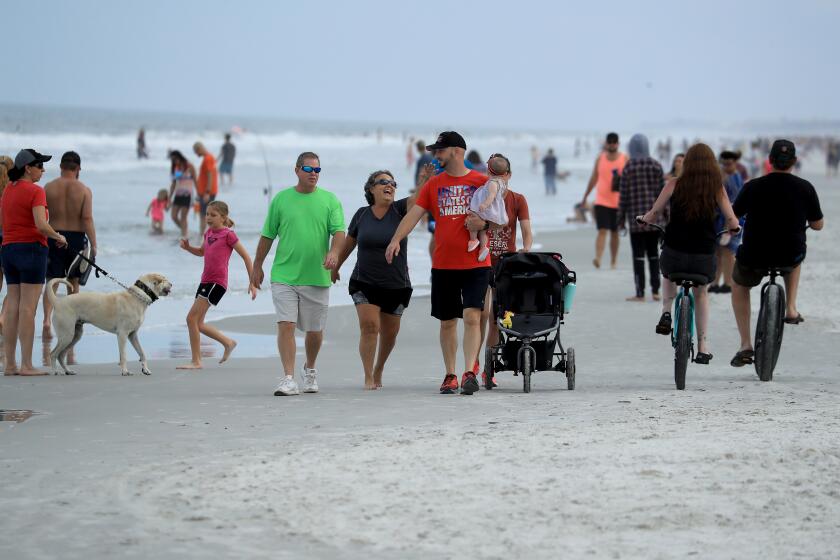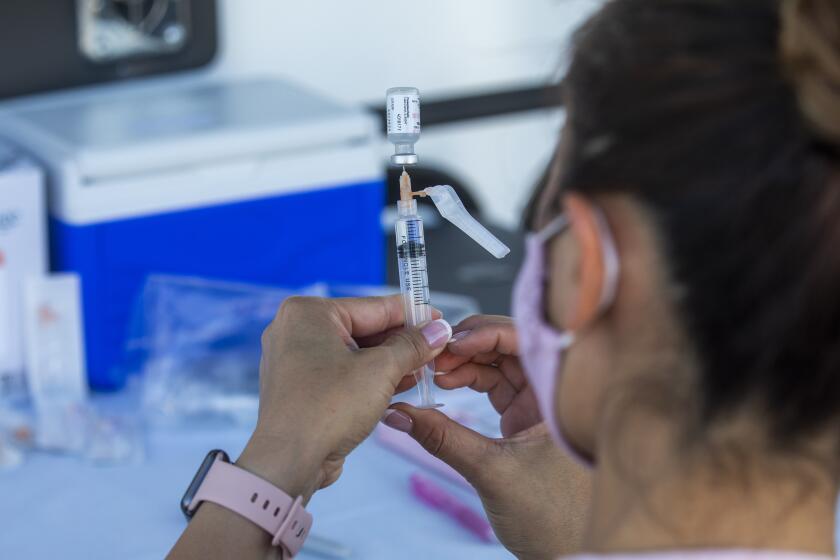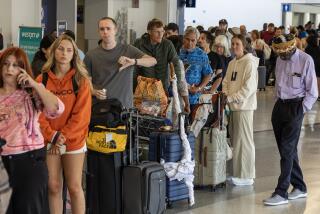Be wary of travel to Nevada, Florida amid COVID surge, L.A. County health officer says

The Los Angeles County health officer has suggested that residents reconsider travel to states with the nation’s worst rates of coronavirus transmission, including Nevada and Florida.
“I do want to recommend — especially if you’re unvaccinated — reconsider traveling to places where the seven-day COVID-19 case rates are increasingly high, like Nevada, our neighbor, or Missouri, Florida, Arkansas and Louisiana and others,” Dr. Muntu Davis said in his briefing to the county Board of Supervisors this week.
Arkansas, Missouri, Florida, Nevada and Louisiana have the nation’s highest levels of new coronavirus cases per capita, with weekly rates roughly four to seven times California’s. All five of those states are considered by the U.S. Centers for Disease Control and Prevention as having “high” rates of community transmission, the worst tier of the CDC’s four-tier scale.
California still is considered as having “moderate” community transmission, the second-lowest tier. In California, for every 100,000 residents, 34.9 have newly tested positive over the past week; the comparable figure for Arkansas is 227.1; for Missouri, 183.8; Florida, 168.8; Nevada, 145.8; and Louisiana, 136.1.
Florida reopened from the pandemic early and is now beating California in the tourism battle.
L.A. County’s per capita weekly coronavirus case rate is higher than California’s but still far lower than the five states mentioned by Davis. L.A. County is now reporting 59.2 new coronavirus cases weekly for every 100,000 residents, categorized as “substantial” community transmission, the second-highest tier. San Diego, Riverside, and Sacramento counties are in the same category: Per 100,000 residents, San Diego County is reporting 58.6 weekly cases; Riverside County, 50.3; and Sacramento, 92.5.
Orange County is reporting 12.4 cases for every 100,000 residents, placing it in the “moderate” community transmission tier. Other Southern California counties in this category include Ventura (15.7) and San Bernardino (48.1).
By contrast, the rate in Florida’s Miami-Dade County is 160.9 weekly cases per 100,000 residents; and in the Sunshine State’s Orange County, home to Disney World, there have been 135.1 weekly cases per 100,000 residents. Both are considered to have “high” rates of community transmission.
Nevada’s Clark County, where Las Vegas is located, has even worse metrics, with 204 new weekly cases for every 100,000 residents. That’s three times higher than L.A. County.
As of Thursday morning, two rural Northern California counties — Siskiyou and Lake — reported “high” rates of community transmission, according to the CDC.
Other California counties with “substantial” transmission include Imperial County east of San Diego; Stanislaus and San Benito counties in Central California; San Mateo, Sonoma, Solano, Napa, Nevada, El Dorado, and Amador counties in the Bay Area and Sacramento regions; and Sutter, Yuba, Butte, Lassen, Mendocino, Humboldt and Del Norte counties farther north.
Door-to-door outreach and vaccine requirements at work would help curb coronavirus spread, experts say.
While fully vaccinated people are well protected against coronavirus infection, and especially hospitalization and death because of COVID-19, doctors say more caution should be taken when community transmission rates are high. The more you’re in contact with the coronavirus, the higher a chance there will be of a “breakthrough” infection, when a vaccinated person still gets the virus.
Some doctors have suggested it’s prudent for even fully vaccinated people to wear masksin areas where vaccination rates are low and virus transmission rates are high.
One San Benito County man told KGO-TV recently that he and his wife — who were both fully vaccinated — contracted COVID-19 during a trip to Las Vegas and then passed the virus on to their children, who are too young to be vaccinated, after they returned home. The family has since recovered, he said.
More to Read
Sign up for Essential California
The most important California stories and recommendations in your inbox every morning.
You may occasionally receive promotional content from the Los Angeles Times.














